This post may contain affiliate links. Please read our disclosure policy.
Simple Lebanese rice pudding (Riz bi Haleeb) prepared with just 6 ingredients (plus the toppings!) and in under 30 minutes. This stovetop rice pudding is creamy, cozy, satisfying, and lightly scented with either orange blossom or rose water—perfect for enjoying as breakfast, a snack, or dessert!
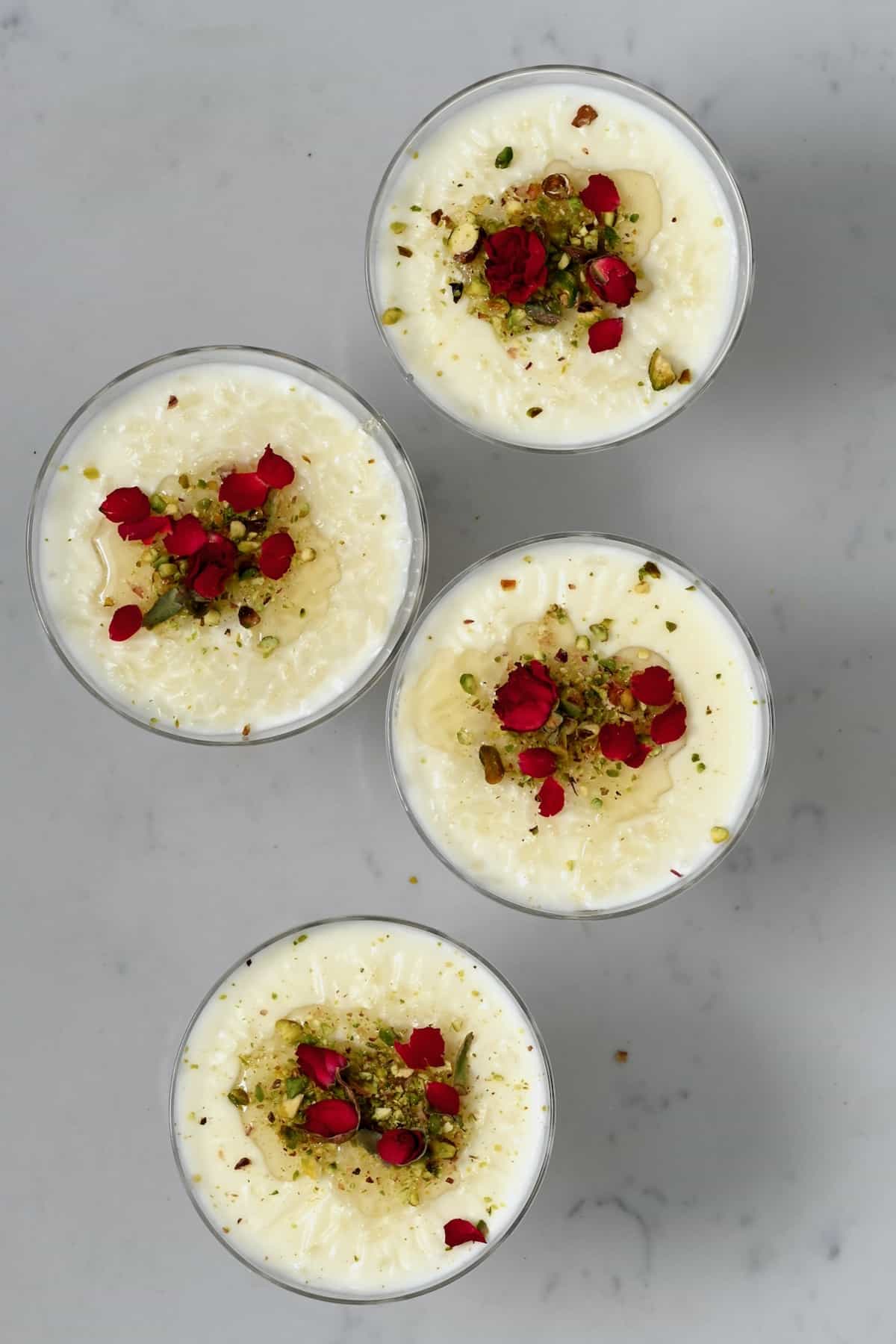
If you already enjoy rice pudding, you’ll hopefully love this Lebanese rice pudding (aka Riz bi Haleeb, which means ‘rice in milk’). This Arabic version sees you cook the rice pudding on the stove, thicken it with cornstarch, and delicately scent it with rose water or orange blossom (just like I do in my baklava recipe and qatayef recipe). All before serving it with a delicious, crushed pistachio topping!
It seems like no matter where you live, there is a rice pudding-style dish that is beloved. In the UK, it’s a ‘school dinner’ staple, and many children will remember the canned versions served at dinnertime. However, rice pudding is also enjoyed across Europe, Asia (including Thai coconut sticky rice!), and the Middle East. Primarily comprising rice with a creamy dairy (milk or a combination of milk and cream), sugar, and then a flavoring (which differs from country to country).
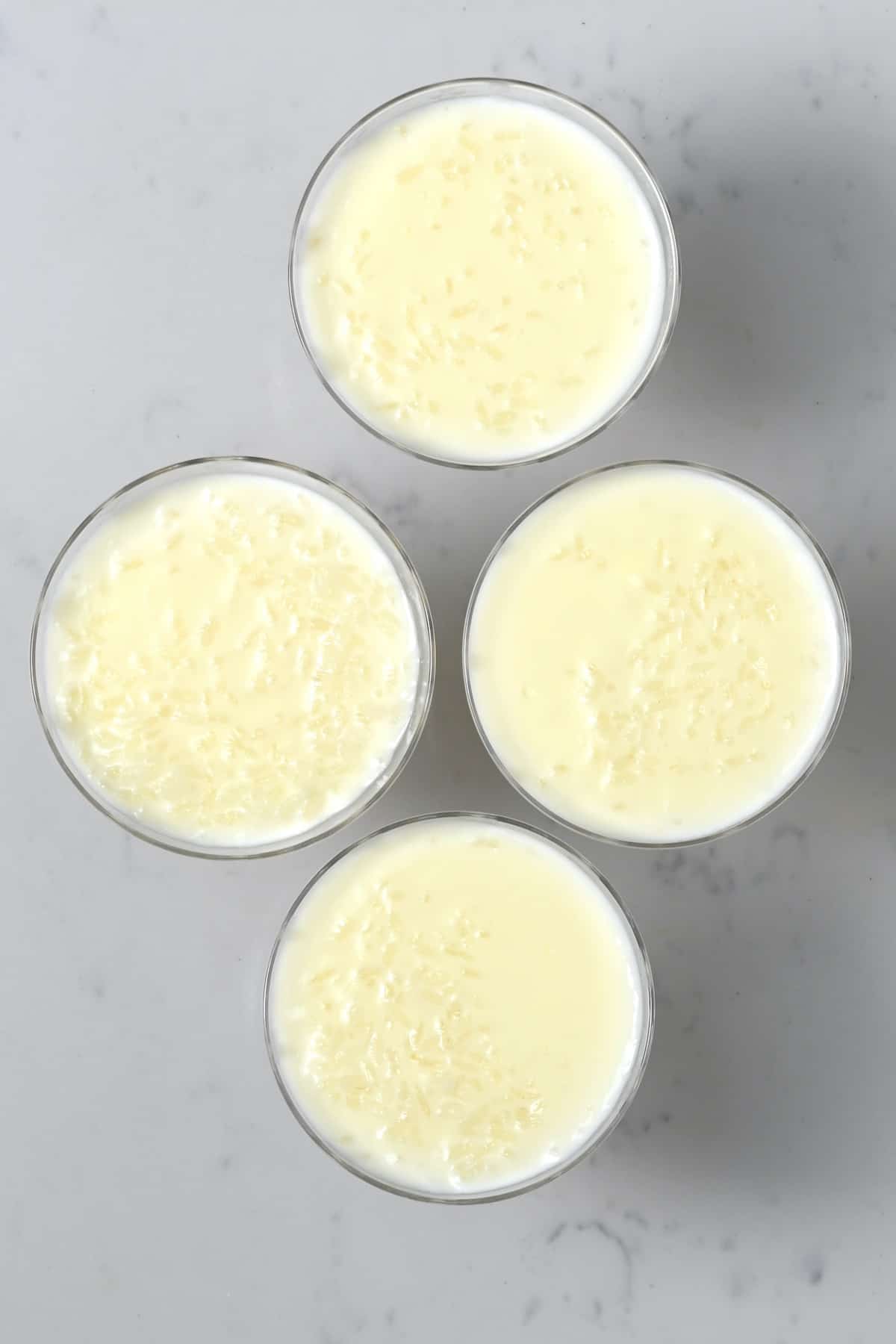
Not only does this Riz bi Haleeb take just a handful of ingredients to prepare, but the method is also super simple: cook the rice, add the remaining ingredients, stir until thickened, then cool, top, and enjoy! While there are plentiful ways to prepare rice pudding (rinse or don’t rinse the rice, cook with the milk, use a slow cooker, rice cooker, stovetop, or the oven, etc.), I’ve found this version of cooking it on the stove is particularly simple, while still achieving delicious results!
Best of all, this Riz bi Haleeb with rose water is fairly versatile, and you can enjoy it for breakfast, as a snack, or dessert!
Want to save this recipe?
Riz bi Haleeb ingredients
- Rice: I recommend using short-grain rice.
- Water: Needed to cook the rice.
- Milk: I prefer to use whole milk for a super creamy rice pudding. However, you could also use 2% if you’d prefer.
- Cream: Use double/ heavy cream for the creamiest results.
- Cornstarch: To thicken the mixture, meaning less time on the stovetop.
- Sugar: Traditionally, we use regular white granulated sugar. However, feel free to experiment with other granulated sugars (like raw cane sugar) or even syrups (like brown rice syrup). Note that each option will vary in flavor and color.
- Orange blossom water and/or Rosewater: These are extremely popular in traditional Middle Eastern rice pudding (and other desserts). You could use one only or a combination of the two.
- Mastic powder: This is optional, but it adds a distinct flavor to the Riz bi Haleeb that I remember from my childhood. If you use it, then make sure to grind it into a powdery consistency (in a mortar and pestle or Ziplock bag and bashed with a rolling pin).
And optional
- Toppings: I used a combination of ground pistachios, dried rose petals (food grade), cinnamon, and a drizzle of honey/dandelion honey or sugar syrup (optional). Mint leaves would also work well.
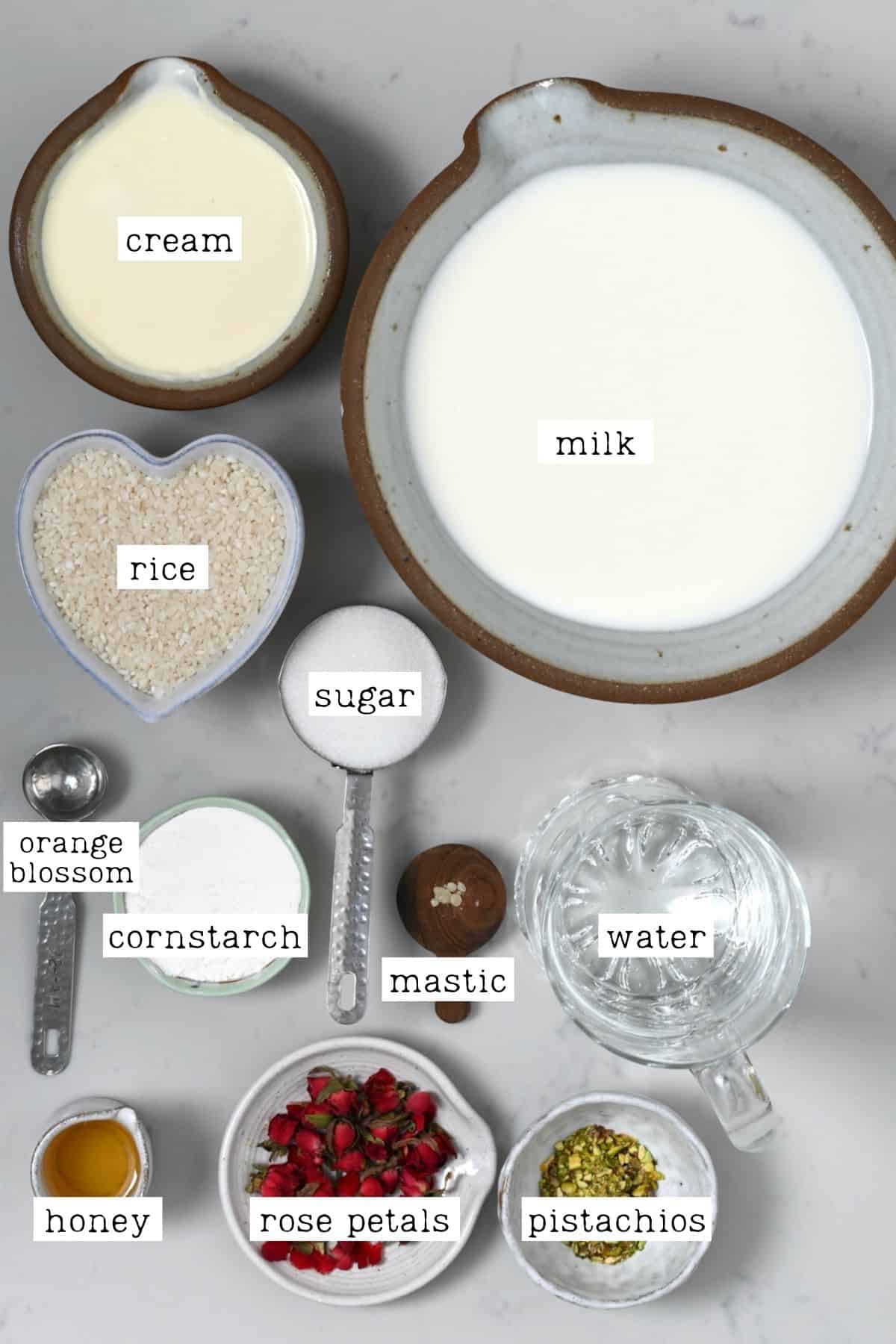
Optional add-ins and variations
- Butter: Make iteven creamier with 1-2 tbsp unsalted butter (when adding the rosewater/ orange blossom).
- Cardamom: Just a small pinch added to the mixture, along with cinnamon, can make for a more spiced dessert.
- Vanilla extract: I use homemade vanilla extract, added to taste.
- Dried fruit: You can serve the Middle Eastern dessert topped with finely chopped dates, dried apricots, or even a handful of raisins for extra sweetness.
- Raisins: A sprinkle of raisins when serving.
- Vegan rice pudding: You can prepare it with the use of dairy alternatives like canned coconut milk (instead of the cream) or another cream alternative, and a full-fat dairy-free milk. Note that the milk you use will affect the flavor, so the results will differ. You can use all milk for a lighter version, but the texture will be thinner and may need more cornstarch (or you can rinse the rice less).
- Jam: You can top the Riz bi Haleeb with a swirl of rose petal jam. Alternatively, step away from the Middle Eastern flavors and mix in some strawberry or raspberry jam. Either way, it will be delicious!
- Sugar-free: You can experiment with using a sugar alternative like erythritol/xylitol. Adjust the amount to taste.
How to make Riz bi haleeb
Step 1: Rinse and cook the rice
First, wash the rice well. To do so, fill a bowl with water and swish the rice until the water is milky. Then, drain and re-fill the bowl until the water is almost clear (usually 3-4 times).
Then, add the rice to a large pan with water and bring to a boil over high heat. Reduce to a simmer and cook for 10-15 minutes or until tender (not al dente).
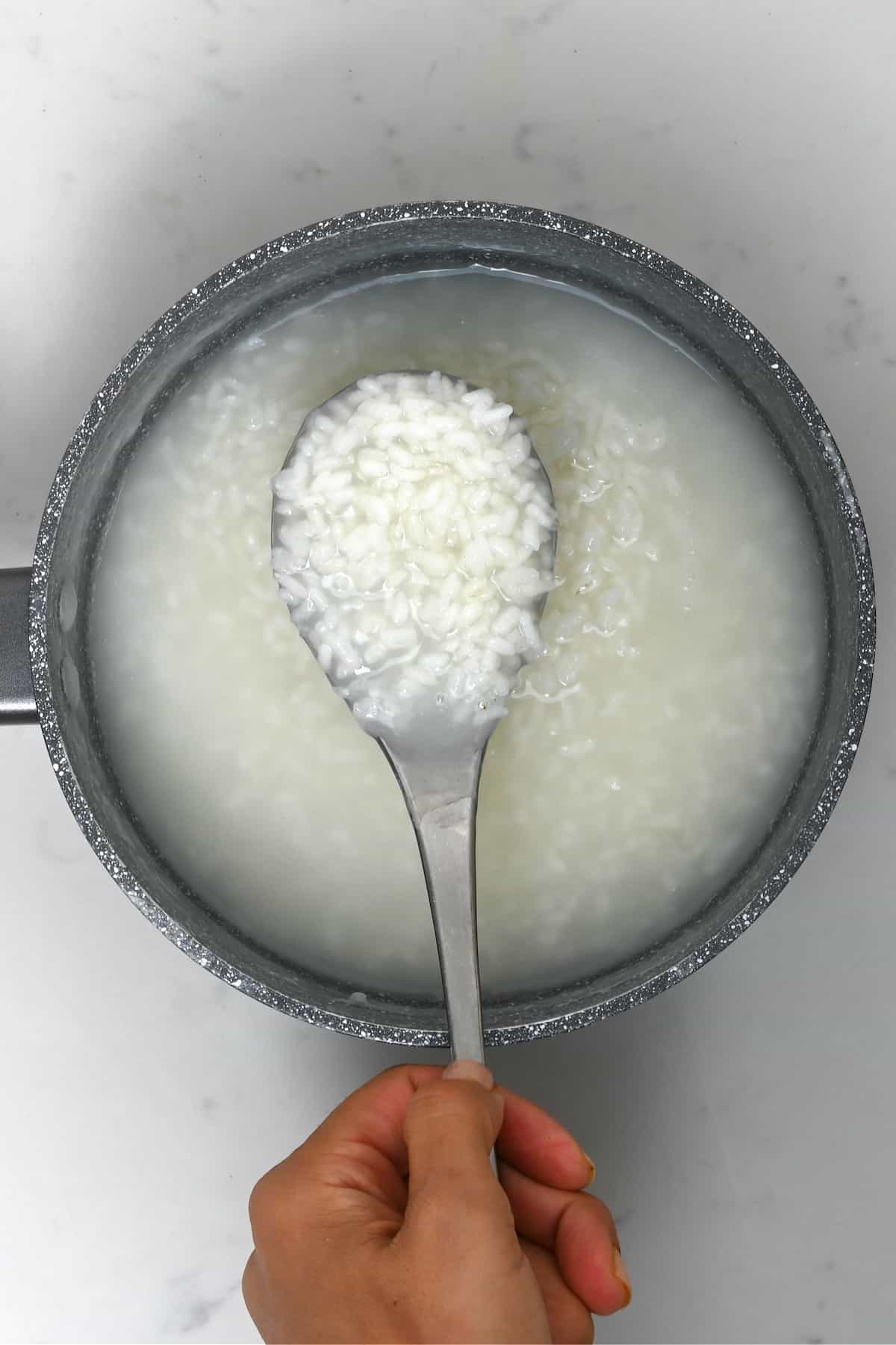
Step 2: Add the remaining ingredients
While the rice cooks, prepare the cornstarch slurry by combining the starch with a small amount of the milk, whisking until it’s smooth and lump-free.
Then, once the rice is tender, Pour in the cornstarch slurry and the remaining milk, cream, sugar, and mastic powder (if used).
There’s no need to drain the rice first. The small amount of starchy water left in the pot will become part of the pudding.
Bring the mixture to a soft boil over medium heat, stirring constantly. Cook for several minutes until it thickens.
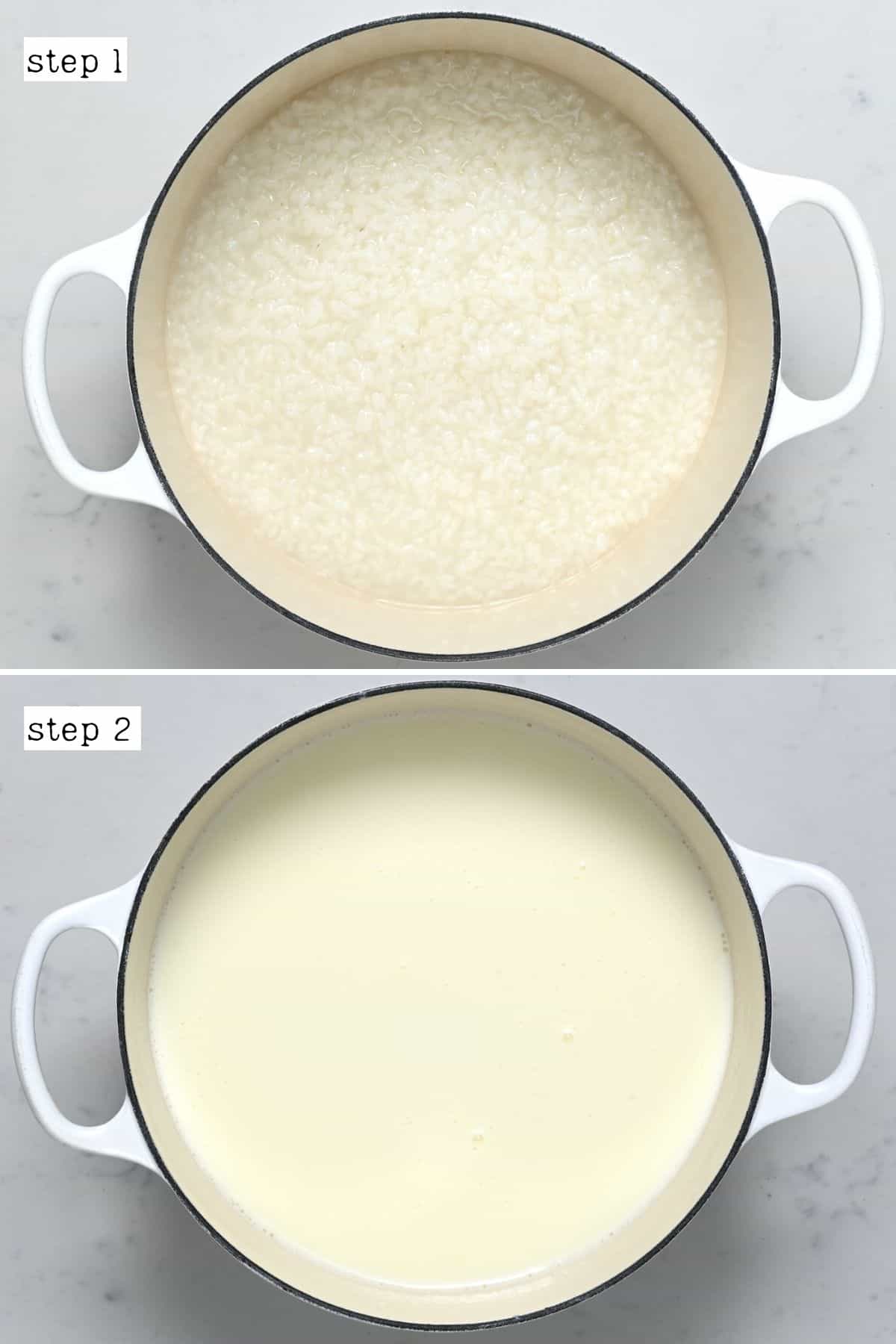
Step 3: Cool and serve the Riz bi Haleeb
Finally, remove the creamy Riz bi Haleeb from the heat and stir in the flavoring (either orange blossom water or rose water), mixing well to incorporate. Allow the mixture to cool slightly (not too long as it will thicken up fairly quickly), then transfer to small serving glasses/bowl.
When you’re ready to serve, garnish with a topping of ground pistachios, dried rose petals, a sprinkling of cinnamon, and a drizzle of honey/ dandelion honey or simple syrup. Enjoy warm, at room temperature, or chilled!
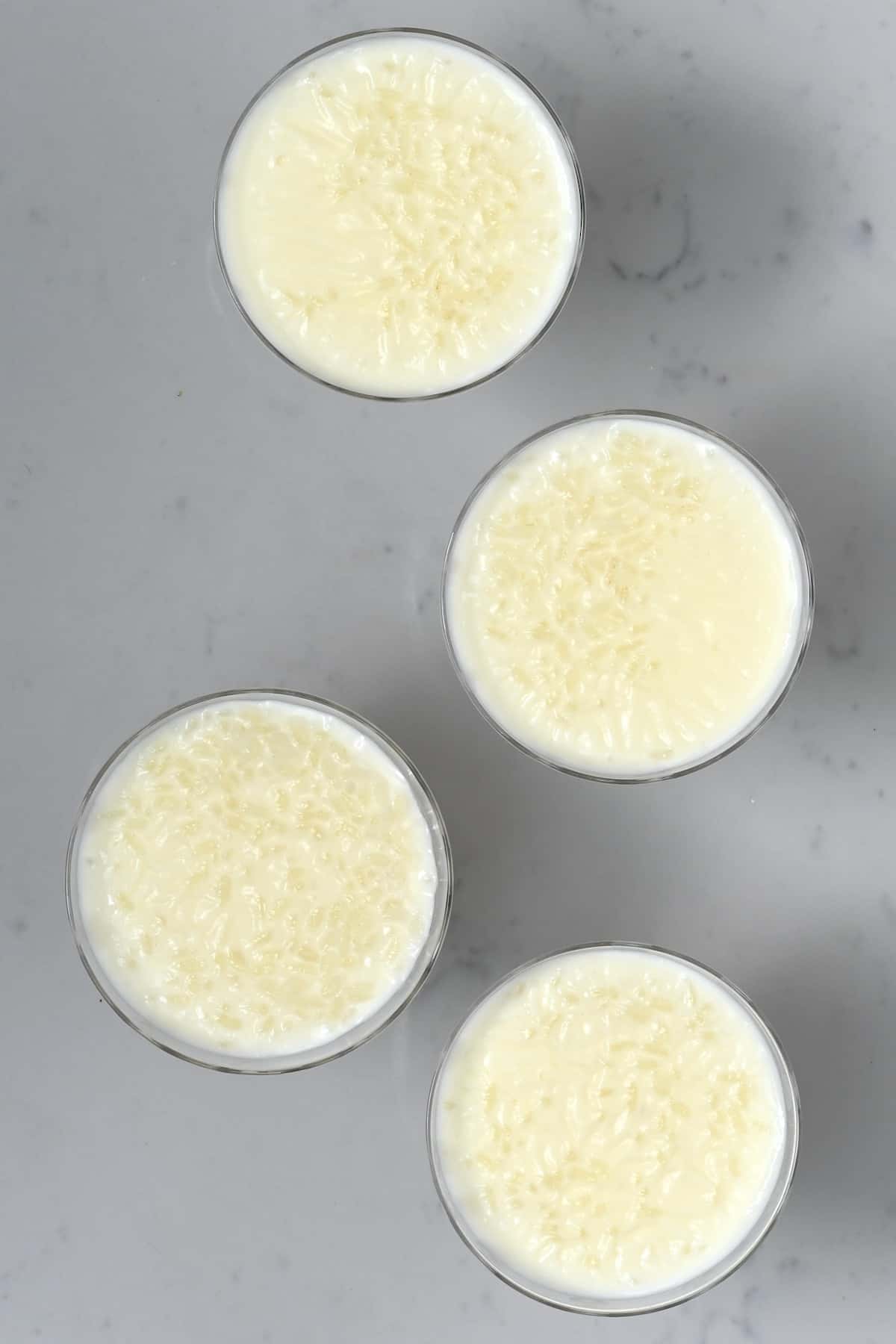
How to make ahead and store
Make-Ahead: You can use leftover cooked rice to prepare Riz bi Haleeb (method in recipe notes).
Store: Allow it to cool before storing any leftovers in the fridge for 4-5 days. I recommend storing with a layer of plastic wrap directly over the surface of the pudding. That way, it will stop skin from forming over the surface (if you prefer it that way).
Reheat: You can enjoy this Middle Eastern dessert chilled, at room temperature, or warm. Reheat on the stovetop or in the microwave (optionally, with an extra splash of milk to help loosen it up if needed).
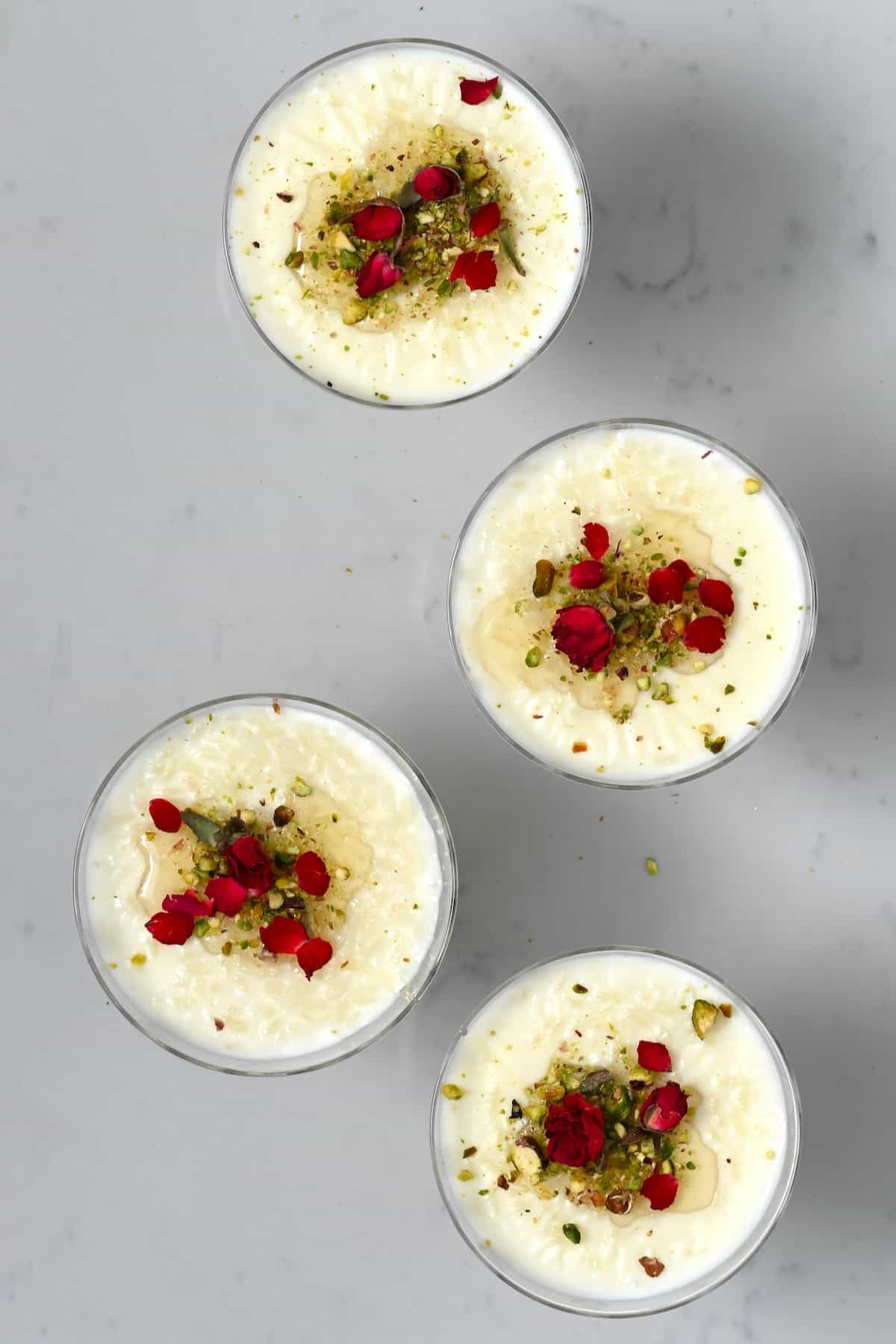
FAQs
Washing the rice gets rid of starch from the outside of the grain. While, technically, you don’t have to wash it as thoroughly as I recommend, leaving any of the starches behind will yield a thicker, starchier Riz bi Haleeb. I prefer mine after washing the rice – but feel free to experiment.
Yes, simply double all the ingredients. The only thing that is likely to change is how long it takes to cook the rice until tender. So, cook it for the recommended time and then check every couple of minutes until it’s ready.
I haven’t tried brown rice with this recipe, so I can’t guarantee results. However, if you wash it well, soak it overnight, and then cook until tender (this will take longer than white rice), it may work.
Honestly, this seems to come down to personal preference. I prefer to use medium or short-grain rice and/or sticky varieties. If using long grain rice, I recommend blitzing it in a food processor/blender first to break it down into slightly smaller pieces.
However, the different rice varieties will also affect the starchiness of the pudding (Starchier varieties make for a creamier rice pudding, even after rinsing).
Recipe notes and top tips
- Adjust the amount of sugar: This can easily be adjusted to taste -so feel free to only add a little to begin and then increase to taste. This is especially important when substituting white sugar.
- Adjust the flavoring: Likewise, adjust the amount of rosewater/ orange blossom water based on how strong you’d like the flavor in the Riz bi Haleeb.
- Cooking time may vary: Especially if you use a different variety of rice.
- If it is too thin/thick: If it’s too thin, you can add a little more cornstarch (around a teaspoon, in a slurry). If it’s too thick, add a little more milk (a few spoonfuls at a time) – until it reaches your desired consistency.
- To make itwith leftover rice: Simply skip the first rice cooking step and start on the stovetop when adding the remaining ingredients. This version won’t be quite as creamy, as there will be no starchy cooking water and leftover rice dries out as it sits in the refrigerator. However, it will be more chewy/textured.
More Middle Eastern dessert recipes
- Qatayef Ashta (Lebanese filled pancakes)
- Homemade pistachio baklava
- Blood orange cake with pistachios
- Easy Knafeh (Kunafa)
- Candied pumpkin (+ pumpkin jam)
- Chocolate hummus (Dessert hummus)
If you try this simpleRiz bi Haleebrecipe, I’d love to hear your thoughts/questions below. Also, I’d appreciate a recipe card rating below, and tag me in your recipe recreations on Instagram @Alphafoodie!

Lebanese Rice Pudding (Riz bi Haleeb)
Ingredients
- 3.2 oz rice short grain, 1/2 cup
- 16 fl oz water 2 cups
- 16 fl oz whole milk 2 cups – or 2% (won't be as creamy)
- 4.2 fl oz cream heavy cream/double cream; 1/2 cup
- 0.45 oz cornstarch 2 Tbsp
- 1.4 oz white sugar 3 Tbsp or raw cane sugar, rice syrup/ You can experiment with sugars (color and taste will vary)
- 1/2 tsp orange blossom water OR rosewater you can use one or a combination of the two. Adjust to taste
- 1/8 tsp mastic powder OPTIONAL
Instructions
Step 1: Cook the rice
- First, wash the rice well. To do so, fill a bowl with water and swish the rice until the water is milky. Then, drain and re-fill the bowl until the water is almost clear (usually 3-4 times).
- Then, add the rice to a large pan with water and bring to a boil over high heat. Reduce to a simmer and cook for 10-15 minutes or until tender (not al dente).
Step 2: Add the remaining ingredients
- While the rice cooks, prepare the cornstarch slurry by combining the starch with a small amount of the milk, whisking until it’s smooth and lump-free.
- Then, once the rice is tender, add the cornstarch slurry and the remaining milk, cream, sugar, and mastic powder (if used).There’s no need to drain the rice first. The small amount of starchy water left in the pot will become part of the dessert.
- Bring the mixture to a soft boil over medium heat, stirring constantly. Cook for several minutes until it thickens.
Step 3: Cool and serve the Riz bi Haleeb
- Finally, remove the creamy pudding from the heat and stir in the flavoring (either orange blossom water or rose water), mixing well to incorporate. Allow the mixture to cool slightly (not too long as it will thicken up fairly quickly), then transfer to small serving glasses/bowl.
- When you’re ready to serve, serve with a topping of ground pistachios, dried rose petals, a sprinkling of cinnamon, and a drizzle of honey or simple syrup. Enjoy warm, at room temperature, or chilled!
How to Store
- Make-Ahead: You can use leftover cooked rice to prepare this Riz bi Haleeb (method in recipe notes). Store: Allow it to cool before storing any leftovers in the fridge for 4-5 days. I recommend storing with a layer of plastic wrap directly over the surface of the pudding. That way, it will stop skin from forming over the surface (if you prefer it that way). Reheat: You can enjoy it chilled, at room temperature, or warm. Reheat on the stovetopwave (optionally, or in the micro with an extra splash of milk to help loosen it up if needed).
Notes
Nutrition
Nutrition information is automatically calculated, so should only be used as an approximation.










Hi, my hubby cant have dairy…is there an alternative for the 2% milk?
Hi Adi,
Perhaps you can try using coconut milk? Let me know if you tried it 🙂
I also like to pour the rice pudding into oven proof bowls, set them into a deep baking dish. I pour enough water to reach bowls half way, then put into oven, on low broil to brown the tops of the pudding. It gives it a rustic flavor.
Mrs. Spencer, thank you for your comment. This is a great alternative cooking method 🙂